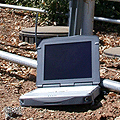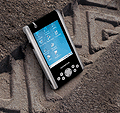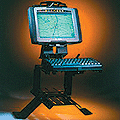|
Slate Computer Taxonomy
A look at all sorts of tablets, pads and slates (2002)
(by Geoff Walker)
Webpads are often confused with other tablet-style computers. Both the media and
the vendors contribute to this confusion -- the media by (sometimes) arbitrarily
categorizing new products, and the vendors by creating artificial new categories
in an attempt to differentiate their products. In this article I propose and use
a tablet taxonomy ("a classification of products based on an ordered system").
This particular taxonomy is based on a mixture of functionality, product
characteristics and common usage. The categories or in the taxonomy include
Internet Appliance, Thin Client, Webpad, CE Tablet, Pen Tablet and Tablet PC.
When referring to a category, the name is capitalized in order to avoid
confusion. The taxonomy is summarized in Table 1.
Internet Appliance
The "Internet Appliance" is the lowest level of the taxonomy. In the most general
sense, an Internet Appliance is any simple device whose purpose is to access the
Internet. "Appliance" is used here in the sense of a toaster or electric can
opener, i.e., a device that is so simple to operate that anyone can use it after
a brief explanation. For the purposes of this article I am defining an Internet
Appliance as a very low-cost, stationary, limited-functionality device whose
purpose is to provide access to the Internet. For cost reasons, the display is
usually a CRT rather than an LCD. Because it isn't portable, an Internet
Appliance typically isn't wireless-enabled by default. The user interface is
typically a very simple browser; it may be pen-enabled but it usually isn't. The
operating system is totally hidden, so it doesn't really matter what it is.
Another common characteristic of an Internet Appliance is that it is almost
always bundled with ISP service (for example, Compaq's Internet Appliance is
bundled with MSN).
There have been a lot of very short-lived products in this category. Some of the
more visible failures include Sony's eVilla (2 months), Virgin's WebPlayer (3
months), 3Com's Audrey (6 months), and Gateway's TouchPad (6 months). Although
the death notices vary for each product, the underlying reason for failure is
that it's very difficult to achieve a balance between low cost, simplicity of use
and enough functionality to be useful. One of the very few Internet Appliances
that has survived into a second generation is Compaq's IA-2. At $299, it's at the
critical price threshold for an Internet Appliance, and it received a favorable
review from Walt Mossberg in the Wall Street Journal. Watch for increased
promotion on this product at Christmas this year.
Thin Client
Next in the taxonomy is the thin client. A thin client is basically a terminal -
"a screen and a keyboard in a box." Another common name for a thin client is
"Windows-based terminal." The purpose of a thin client is to provide a physical
user interface to an application running on a server. Applications never execute
directly on a thin client's hardware; the basic purpose of the (embedded) OS in a
thin client is to operate the screen and the keyboard. There are two main
software environments (protocols) in which thin clients exist: ICA (Independent
Computing Architecture) from Citrix, and RDP (Remote Display Protocol) from
Microsoft. The purpose of both of these protocols is to provide efficient
transfer of screen updates and keystrokes between the thin client and the server.
To function as a thin client, a device must include a driver to support either
ICA or RDP.
Thin clients exist mainly for cost reasons - why use a full PC when all you
really need is a terminal? Most thin clients are not portable; the typical form
factor looks like a large hardback book standing on edge. Historically the most
notable portable thin client was the Zenith CruisePad. The CruisePad was a
dedicated, single-purpose product; all it could do was be a thin client. One
reason was that it had a proprietary OS. Today there aren't any dedicated
portable thin clients on the market, with one exception (see the sidebar on
AirSpeak's Flair). A representative example of a traditional thin client is NCD's
ThinSTAR.
Most thin clients on the market today are not portable; they're designed for use
on a wired LAN. There is, however, substantial demand to connect via wireless LAN
to a server application in vertical markets such as healthcare, automotive
auctions & damage claim estimating, hospitality in restaurants, in-store retail
support, etc.). Today these applications are typically accomplished using a
Webpad, a CE Tablet or a (Windows) Pen Tablet rather than a portable thin client.
The reason may be that there is often a horizontal component to many vertical
applications which requires additional standalone computer power that's not
available in a "true" thin client. On the other hand, the reason may be that
there aren't any portable thin clients on the market (chicken and egg?).
Webpad
Building on the previous description, a Webpad is like a thin client for the
Internet. Instead of ICA or RDP, the operating software environment is a browser.
Unlike thin clients, Webpads are by definition portable, which means they
typically include wireless LAN capability. The most common operating system used
in Webpads today is Windows CE, followed by Midori(TM) Mobile Linux. QNX (from QNX
Software Systems) runs a distant third.
One of the things that makes Webpads interesting and different is that they can
span multiple categories. A Webpad can act like a portable Internet Appliance
(for the consumer at home), like a Thin Client in the enterprise (for wireless
access to the corporate LAN) or like a CE Tablet (running dedicated applications
in hospitality or healthcare). Refer to the main article for more details about
Webpads.
CE Tablet
Moving up one step the food chain, a CE Tablet can be viewed as a Webpad with
additional flash storage to allow it to run standalone Windows CE applications.
Typically a CE Tablet also has some specific adaptations for vertical markets,
such as additional I/O ports, enhanced ruggedness or integrated wide-area
wireless. A CE Tablet can function as a Webpad, it's just that doing so is
generally overkill from a cost point of view. A representative example of a CE
Tablet is the Fujitsu PenCentra.
Pen Tablet
The crossover factor between the four categories discussed so far and a Pen
Tablet is the presence of full-scale Windows (9x, NT, 2000 or XP) in the latter.
With few exceptions, Windows requires a hard disk, which is one of the key
hardware differences between the first four categories and the final two.
However, some Webpads can be configured with or without a hard disk (for example,
SONICblue's ProGear). In the tables accompanying this article, I have designated
these as "hybrid" Webpads.
Tablet PC
A Tablet PC is a Pen Tablet that meets the requirements of Microsoft's Tablet PC
platform specification. The list of Tablet PC hardware requirements is actually
quite short. It includes the following:
- Must use an active digitizer rather than a resistive (touch)
digitizer
- Must be legacy-free (no serial, parallel or PS/2 ports)
- Must be
able to rotate the LCD image between landscape and portrait without rebooting
- Must resume from suspend in less than 2 seconds
- Must last in suspend for
more than 72 hours, starting with a full battery
- Must automatically hibernate
(save to disk) upon battery exhaustion in suspend
- Must allow surprise removal
from a dock; upon reinsertion, everything must work
Tablet PCs aren't shipping yet -- Microsoft is expected to release the first
version of Windows XP Tablet in the third quarter of 2002. Once Tablet PCs start
shipping, I expect that most Pen Tablet vendors will upgrade their existing Pen
Tablets into Tablet PCs as a result of Microsoft's ability to set market
standards. In the interim, there will probably be some confusion in the
marketplace as vendors rename their existing Pen Tablet products as Tablet PCs to
take advantage of the publicity surrounding Microsoft's launch of the Tablet PC.
Based in Silicon Valley, Geoff Walker is a consultant with Walker Mobile. Geoff has worked on the engineering and marketing of pen computers since 1990 at GRiD
Systems, Fujitsu Personal Systems (now Fujitsu PC) and Handspring. He can be contacted at geoff.walker@att.net.
|












